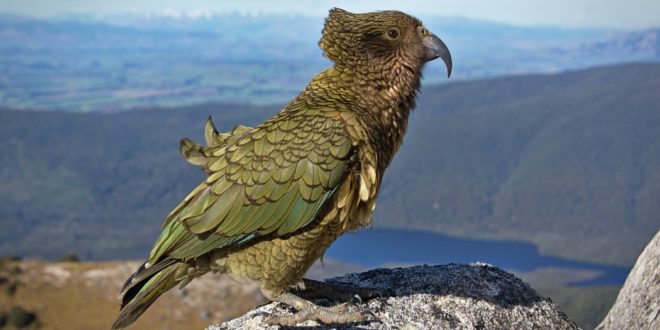Cheeky, curious, comical and cute; kea are the only member of the parrot family to live in alpine regions. Yet that doesn’t mean you have to go mountaineering in order to enjoy an up-close encounter with these amusing avian tricksters. There are several easily accessible spots in the South Island where you can almost guarantee kea sightings just a few steps from your car.

Arthur’s Pass Village
The alpine village of Arthur’s Pass is home to a band of feathered ruffians. To reach them, take highway 73 west from Christchurch. The journey is a scenic 2 hour tour through the Canterbury plains and up into spectacular mountain scenery. Alternatively, book the TranzAlpine express and sit back in style. A return ticket allows 5 hours in the village which gives plenty of time for kea spotting. The reckless parrots are to be found teasing the tourists in the vicinity of the public toilets or swaggering about outside the local café. Treat yourself to coffee and cake and be sure to sit at one of the outdoor tables to catch the kea strutting their stuff.
Monkey Creek
 Just an hour and twenty minutes from Te Anau on State Highway 94 in the direction Milford Sound, Monkey Creek is one of the prettiest spots on this popular tourist route. Said to be named after a faithful dog belonging to 1880s European settler and surveyor William Henry Homer, Monkey Creek is one of the best places for kea sightings. Whether you’re in a rental or driving your own car, you’ll want to keep a close eye on your vehicle. While the parrots are busy amusing you, their cousins may well be visiting your car! Mischievous beaks can quickly tear off rubber trim around windows, nip windscreen wipers and damage side mirrors.
Just an hour and twenty minutes from Te Anau on State Highway 94 in the direction Milford Sound, Monkey Creek is one of the prettiest spots on this popular tourist route. Said to be named after a faithful dog belonging to 1880s European settler and surveyor William Henry Homer, Monkey Creek is one of the best places for kea sightings. Whether you’re in a rental or driving your own car, you’ll want to keep a close eye on your vehicle. While the parrots are busy amusing you, their cousins may well be visiting your car! Mischievous beaks can quickly tear off rubber trim around windows, nip windscreen wipers and damage side mirrors.
Homer Tunnel
Kea are mischievous and never more so than at the Te Anau side entrance to the Homer Tunnel 102 kilometres from Te Anau on the road to Milford Sound. In 2016, New Zealand Transport Authority staff were puzzled to find their Homer Tunnel road cones in unusual places. When they reviewed camera footage they discovered the local kea were shifting the cones for the sheer fun of it! Spot these unusual ‘road workers’ for yourself by pulling into the parking bays outside the tunnel. If taking photos, be sure to shut the car door behind you. Not only is your upholstery at risk from sharp beaks but fun-loving kea (which have been said to possess the intelligence of a 4 year old child) are interested in anything that sparkles – and that includes the keys to your vehicle!
Kea-watching etiquette
Enjoy watching kea antics but resist the urge to feed these wild birds. A kea’s natural diet consists of berries, shoots, roots and insect larvae. By comparison, human food is high calorie which means that kea feeding off it can save their energy for getting into mischief. Unfortunately, this mischief includes chewing at toxic lead flashings. Feeding juvenile kea also means they are less likely to learn how to look after themselves by searching for food in the wild – something which can lead to malnutrition or even starvation. While enjoying watching kea, keep your belongings secure and close to you at all times. Kea are inquisitive as well as destructive. Your belongings are not good for them and kea are not good for your belongings!








Join the Discussion
Type out your comment here:
You must be logged in to post a comment.